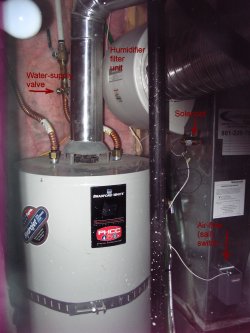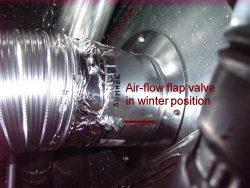Honeywell HE220A Humidifier
Part number HC22A1007 Honeywell support: 800 468-1502
Note: This appliance never worked particularly well, was a pain to service and, ultimately, it was replaced by an AIRCARE EP9 800 Whole-House Pedestal-Style Evaporative Humidifier. This humidifier requires filling every day, but it suffers from none of the problems of the Honeywell.
Instructions for changing out humidifier filter.
The replacement filter number is also noted on the humidifier-maintenance decal on cold-air return. Perform maintenance on this unit at end of heating season in spring or before heating season begins in fall.
I supplied soft water to the humidifier in order to minimize the amount of hard-water deposits likely to degrade the filter prematurely. I supplied cold water to ensure there is no impact to the amount of hot water in the house.
Click on illustrations to make them bigger. The first illustration is useful to almost all the instructions here.
Steps to replace filter

- The only nasty thing about this duty is that part of the water heater duct must be removed temporarily. Turn the water heater to PILOT instead of ON (do not turn it OFF).
- Remove screw in water heater flue immediately above the humidifier filter unit. Remove flue from top of water heater (pop out the four legs) and from rest of flue. Set aside.
- Undo the large, knurled aluminum nut underneath filter unit. This screw does not come out, but only undoes the cover. Remove the cover and set aside.
- The filter is housed in a black plastic frame that makes the whole thing look vaguely like a car radiator. Gently pull on the far side of the frame until the unit comes out, top first, into your hands. Disconnect the water tube from the top of the unit.
- Disassemble the filter frame, remove the naked filter and discard only the latter. Clean the black plastic frame thoroughly as it is not disposable. Ensure that no holes are plugged.
- Reassemble the filter frame with a new filter. Reinstall the filter frame into the greater humidifier filter unit by first reconnecting the water tube, then, minding the water tube does not get caught between the frame and the unit, insert the frame bottom first, then pressing gently on the top of the frame until it seats.
- Reposition the unit cover and reinstall the water heater flue by reconnecting it to the rest of the flue with the screw, then firmly working the four legs of the connector back into their holes in the top of the water heater.
Other service items
- Ensure the drain tube is not clogged and reaches down to the floor drain.
-
 Position the air-flow flap valve at the end of the humidifier duct to
the appropriate position for the season: winter for humidity and summer for
refrigeration. Keep the wing nut as tight as possible, but don't tighten it
using any tool except your fingers.
Position the air-flow flap valve at the end of the humidifier duct to
the appropriate position for the season: winter for humidity and summer for
refrigeration. Keep the wing nut as tight as possible, but don't tighten it
using any tool except your fingers.
- Ensure that the electrical connections that link the transformer, hygrometer, the solenoid valve on the filter unit and the air-flow sensor on the cold-air return are live. This should never involve more than ensuring that the outlet the transformer is plugged into is live.
- If the humidification system is working, the knob on the hygrometer controls the level of relative humidity. If there is a great deal of condensation inside on the windows of the house, then it might be too high. It should be set as high as possible, but not so high as to create this humidity problem. Allowing there to be too much relative humidity leads to the development of molds and maintenance problems.
Vacation and summer tasks
- When going on vacation, turn the water valve off to the humidifier system. It is a little bronze valve located above and behind the hot water heater. Turn clockwise to turn off. Do not tighten this value down hard. Similarly, when turning it back on, do not back it out completely. To be certain you're supplying water without turning it on too much, set the temperature at the thermostat upstairs hot enough to make the furnace run and turn the humidity up all the way. Back the value out by turning counter-clockwise slowly until you see water dripping out through the clear drain hose. Then do one turn more.
- When going on vacation, turn the humidity control to OFF. This control is located in the den above the closet door. Elsewhere, this control is referred to as the hygrometer or humidistat.
- For summer, at the end of the heating season, turn off both the water and the humidity control. Also, turn the air-flow flap valve off at the root of the humidity duct. Turn it to the "summer" position.
Returning from vacation or beginning the heating season
- Turn the water on (see "Vacation and summer tasks").
- Turn the humidity control to the desired setting (see "Other service items").
- Turn air-flow valve to "winter" position (see Vacation and summer tasks).
- To fine-tune the amount of water, keep turning down (clockwise, to off) the water valve until very little comes out of the drain hose. This will a) save water and b) save on the amount of water running through the filter (which in part is what reduces its life).
How to tell that the humidifier is working properly
- Ensure power is on to both furnace and humidifier.
- Ensure furnace ventilator (fan) is running. The sail switch (or air-flow switch) detects whether air is flowing in the system. If it isn't, the solenoid will not get power from this switch and permit the water to flow into the humidifier filter.
- If the hygrometer/humidistat is set too low, it too will deny power to the solenoid. (This is the control mounted in the den above the closet door.)
- With the furnace running and everything set up to make the humidifier work, you should see water running down the clear drain tube from the humidifier filter until shortly after everything has been running.
How the humidifier works...
- Pressurized air enters from the warm-air plenum atop the furnace traveling through the duct to the humidifier filter unit.
- The air in the unit travels through the filter into the cold-air return plenum. As it passes through the filter, it evaporates water dripping through the filter pad (the part that's replaceable). This air becomes moister for the water added into it. (The solenoid near the water tubing at the bottom of the filter unit controls whether water can flow into the filter pad.)
- The moister air is drawn by the furnace blower through the furnace filter and into the burners below the warm-air plenum and is sent up through the house duct system.
- In fact, the humidifier works in exactly the same way as the evaporative (swamp) cooler. The latter produces cool air because the air it pulls in through its wet filter pads evaporates the water. It takes heat energy to evaporate the water and thus the air gets cooler (but also more humid, which is why evaporative coolers won't work in places like Houston, Texas).